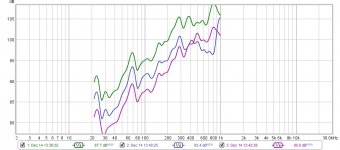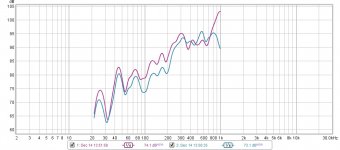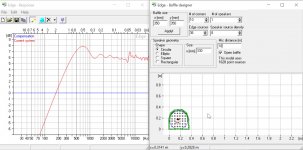This compound sub construction was discussed in some threads, also here Electro-acoustic models Searching for "legacy whisper" will give some results as well.
I did a test with two SB34NRX75-16. I compared a single unit, two units as shown by k9vap and two units side by side.
Single unit produced SPL x, Without changing the amplifiers settings, I just wired the 2nd woofer in parallel to the 1st woofer. Put the side by side, and got a 6dB increase in the output (as expected). Than I put the as shown by k9vap, and it resulted in an output increase of 3dB.
Apparently the compound woofer setup changes the characteristic dipole directivity, making it even more directive (more output to the front, less to the sides), but I have not seen actual measurements for that!
best regards,
Erik
I did a test with two SB34NRX75-16. I compared a single unit, two units as shown by k9vap and two units side by side.
Single unit produced SPL x, Without changing the amplifiers settings, I just wired the 2nd woofer in parallel to the 1st woofer. Put the side by side, and got a 6dB increase in the output (as expected). Than I put the as shown by k9vap, and it resulted in an output increase of 3dB.
Apparently the compound woofer setup changes the characteristic dipole directivity, making it even more directive (more output to the front, less to the sides), but I have not seen actual measurements for that!
best regards,
Erik
12" units on the 6000 quite limiting.
No issues using UM18's

Hi k9vap,
I looked through your posts before, but I did not know you were Vic from Trans-Fi Audio I really like your lenghty dipole speakers thread at lenco heaven, and what I like most is that in the end you got to such a "simple design". And I mean that in a positive way: very easy construction (now wood dust and speaker finishing...), 2 way only. Unfortunately I can not place a speaker like yours in my living room (there is always a lot of kids running through the house), but I am working on something at the moment...
Thanks again for the lenco heaven thread, very inspiring!
Erik
There is an acoustic short circuit in your setup.
Right now the pressure created by the rear sub with its driver moving forward gets cancelled by the under-pressure created by the front driver moving forward and vice versa.
Only rear driver rear surface and front driver front surface are doing the work.
The efficiency of the dual subs is +6dB that of a single driver but the SPL is still as much as a single sub.
If you place the subs side-by side or one on top of the other so their driver cone surfaces lay in line that would eliminate the acoustic short circuit and the SPL output would go up by 6dB.
If you still want them keep one in front of the other you can place a barrier in between them on angle as long as the barrier reaches of goes past the opposite ends of edges of the drivers where the dipole acoustic nulls are - like that: I/I
Hope that helps.
Thanks for the advice, but I arrived at this configuration after going through a myriad of combinations over the last 10 years. In my experience, trying to 'force' the air with baffles, U frames, W frames, H frames will indeed increase the bass, but also pressurizes the room causing dramatic modes in some cases. This setup is giving the best extended and even bass I have yet experienced.
As a matter or curiosity, have you ever tried this configuration?
Thanks for the advice, but I arrived at this configuration after going through a myriad of combinations over the last 10 years. In my experience, trying to 'force' the air with baffles, U frames, W frames, H frames will indeed increase the bass, but also pressurizes the room causing dramatic modes in some cases. This setup is giving the best extended and even bass I have yet experienced.
As a matter or curiosity, have you ever tried this configuration?
No, I have not tried this configuration.
If you place the subs drivers close enough so the drivers are touching then the enclosed air will not get exchanged and the subs will work exactly like 1 single sub with +6dB extra sensitivity.
When you start pulling the subs apart the pressure wave from one driver gets more chance to envelope the other driver and not get completely cancelled out by it.
It's an interesting arrangement you have.
Any idea why it interacts differently with the room modes than a single dipole sub driver would?
No, I have not tried this configuration.
If you place the subs drivers close enough so the drivers are touching then the enclosed air will not get exchanged and the subs will work exactly like 1 single sub with +6dB extra sensitivity.
When you start pulling the subs apart the pressure wave from one driver gets more chance to envelope the other driver and not get completely cancelled out by it.
It's an interesting arrangement you have.
Any idea why it interacts differently with the room modes than a single dipole sub driver would?
In a smaller room one would probably work just as well. This arrangement for me evolved once I got used to working with 2 woofers locked together, initially with 15" units held on a wooden cradle frame by the magnets, eventually leading to a suspended arrangement on a metal frame. Probably would never have arrived at this design working with a single woofer.
This is an interesting post (and thread) on the compound woofer. https://www.diyaudio.com/forums/multi-way/46111-legacy-whisper-bass.html#post3897099
This is an interesting post (and thread) on the compound woofer. https://www.diyaudio.com/forums/multi-way/46111-legacy-whisper-bass.html#post3897099
Indeed Erik. It seems this arrangement causes a powerful null in between the speakers that may help reducing room modes. In my Lenco Heaven thread one person referred to it as a 'phantom baffle'
This compound sub construction was discussed in some threads, also here Electro-acoustic models Searching for "legacy whisper" will give some results as well.
I did a test with two SB34NRX75-16. I compared a single unit, two units as shown by k9vap and two units side by side.
Single unit produced SPL x, Without changing the amplifiers settings, I just wired the 2nd woofer in parallel to the 1st woofer. Put the side by side, and got a 6dB increase in the output (as expected). Than I put the as shown by k9vap, and it resulted in an output increase of 3dB.
Apparently the compound woofer setup changes the characteristic dipole directivity, making it even more directive (more output to the front, less to the sides), but I have not seen actual measurements for that!
best regards,
Erik
Just went through my measurements, and found the ones I made for the test described above. It was quick and dirty test (with room influences...), but it shows the trend, I think.
The most interesting is the curves shown for single unit (violet), compound (blue) and side by side (green). One sees that compound has indeed 3dB more output than single, and the side by side 6dB more as the single.
Also, unfortunately I saw this later only, member Bolserst mentioned that for the compound woofer dipole peak goes one octave up. I measured to 1000Hz only, and the dipole peak should form around 700Hz for these 12" drivers, but one sees that the compound woofer output goes below the single unit from 450Hz onwards.
Last, a measurement taken at 90° of the single and compound woofer. While at ONaxis the output was about 3dB higher, at 90° the outputs are much closer, so does the compound really output less to the sides?
Attachments
Indeed, the drivers were connected in parallel. These drivers are 16 ohm, so good for connection in parallel.
So, for same excursion (same voltage coming from the amplifier), the output of the compound dipole is 3dB higher. Eventually it is the excursion that is the limiting factor in determining the dipole SPL, so I am quite sure that it does not matter if the drivers are in series or parallel to obtain the 3dB increase... the difference between series or parallel connection will be mostly dictated by the amplifier's capability to drive the speakers. One can also use two amplifiers, one for each speaker.
Best regards, erik
So, for same excursion (same voltage coming from the amplifier), the output of the compound dipole is 3dB higher. Eventually it is the excursion that is the limiting factor in determining the dipole SPL, so I am quite sure that it does not matter if the drivers are in series or parallel to obtain the 3dB increase... the difference between series or parallel connection will be mostly dictated by the amplifier's capability to drive the speakers. One can also use two amplifiers, one for each speaker.
Best regards, erik
Hi Erik
Actually, the positive thing for me is that there is indeed an increase in SPL in coupled dipole configuration, albeit 3dB lower than when side by side. Linkwitz mentioned the increase but I wasn't sure how that could be. Thanks for proving that.
An interesting point on excursion is that Linkwitz claims a 8 X excursion increase for every octave down whereas many people seem to think it is only 4 X. I've downloaded one of his calculators that clearly show this.
There's some skepticism over the coupled dipole - Linkwitz never tried it, I believe - but Vic proved it works and I'm following in his footsteps more or less.
Actually, the positive thing for me is that there is indeed an increase in SPL in coupled dipole configuration, albeit 3dB lower than when side by side. Linkwitz mentioned the increase but I wasn't sure how that could be. Thanks for proving that.
An interesting point on excursion is that Linkwitz claims a 8 X excursion increase for every octave down whereas many people seem to think it is only 4 X. I've downloaded one of his calculators that clearly show this.
There's some skepticism over the coupled dipole - Linkwitz never tried it, I believe - but Vic proved it works and I'm following in his footsteps more or less.
I liked them a lot, they went up to 400Hz very well. Still I changed my speakers and will reuse the SBs as actual subwoofers, up to about 60Hz. So yes, they are good.
Eg daudio S2 is made with 2 of these products | Daudio - dipole – design – audio
Eg daudio S2 is made with 2 of these products | Daudio - dipole – design – audio
- Status
- This old topic is closed. If you want to reopen this topic, contact a moderator using the "Report Post" button.
- Home
- Loudspeakers
- Subwoofers
- Celestion System 6000 vs GR Research dipole bass


